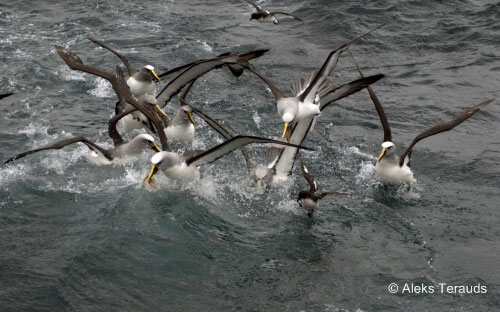Leigh Torres (National Institute of Water and Atmospheric Research, Wellington, New Zealand) and colleagues, writing in the journal Marine Ecology Progress Series, have looked at how closely albatrosses and fisheries interact, as opposed to them just being in the same geographical area.
The paper's abstract follows:
"Seabird-fishery interactions are currently a major issue in marine conservation management. A common approach to quantifying the extent of interactions is to overlay density maps of seabird and fishing activities derived from point locations. Such large-scale evaluations of overlap can be misleading due to the static representation of birds and vessels that in reality are spatially and temporally dynamic. Additionally, overlap at large scales does not necessarily indicate interaction; overlapping distributions of seabirds and fisheries could reflect coincident use of habitat. Using 4 yr of distribution data, we conducted a fine-scale analysis of overlap between albatrosses and fishing vessels. Results were compared to those derived from large-scale density comparisons. Additionally, we compared overlap versus interaction rates by calculating the proportion of time that birds foraged in close association with a fishing vessel versus independently while within 10 km of a vessel. Results of our fine-scale analysis indicated generally low rates of overlap while foraging and high variability among sexes, years and types of fishery. Changes in overlap rates were attributed to shifts in both albatross and vessel distributions. Albatrosses foraged independently of fishing vessels half the time they were within 10 km of a vessel, indicating that 50% of overlap is due to coincident habitat use rather than vessel interaction. Overlaying of large-scale distribution maps failed to distinguish annual variation in the degree of bird-fishery overlap, and suggested overlap where none was identified at the finer scale. This study illustrates the increased insight derived from fine-scale analyses of seabird-fisheries interactions."

Buller's Albatross Thalassarche bulleri feeding at sea. Photograph by Aleks Terauds
Reference:
Torres, L.G., Sagar, P.M., Thompson, D.R. & Phillips, R.A. 2013. Scaling down the analysis of seabird-fishery interactions. Marine Ecology Progress Series 473: 275-289.
Click here for an ACAP news item featuring a related publication co-authored by Leigh Torres.
John Cooper, ACAP Information Officer, 28 January 2013

 Español
Español  English
English  Français
Français